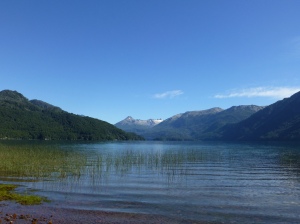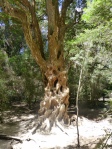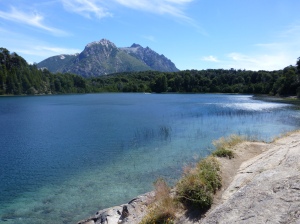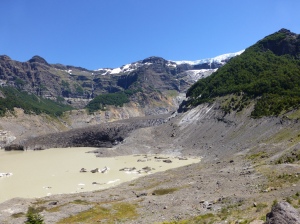Our 44 hour journey from Puerto Iguaçu went about a smoothly as it could. The one sour note, ironically actually a sweet note, came in the form of one of the items served to us as part of our dinner. I have mentioned previously that ham and cheese makes, without fail, an appearance at every meal served on Argentinian buses. I now suspect there must be some kind of legislation in place that enforces it’s serving at every opportunity. Our dinner consisted of not one helping of the aforementioned double act, not two, not even three. We were served four different* portions of bread, ham, and cheese. However, it was not the quantity of Jamon y Queso that struck the sour (sweet) note, but rather one of the items in particular. The offending morsel looked somewhat like a slice of vanilla Swiss roll, the washed out pink of the ham and pale yellow of the cheese spiraling toward the centre on the inside of the sponge. It couldn’t be, we thought. We tasted. It was. Ham and cheese cake.
Our accommodation, at B&B Antiguo Solar, was great and the owner, Bernardo, really friendly and helpful. On our first full day, given that the weather was so perfect, we set off for a day long hike around the Nahuel Huapi National Park. We caught bus number 25 from the city centre and after bumping our way along an uneven dirt road for around 40 minutes alighted a pleasant 40 minute stroll from the park boundary. We were accompanied for a time by one of the local stray dogs, which have a habit of latching on to any passersby who don’t stare angrily at them.
Upon crossing into the park proper (after shooing our unwanted companion away with an angry shout) we entered a forest of huge Coihue trees. These giants have towering, branchless, trunks reaching 40-50 meters; a wide umbrella of foliage spreads out only from the very top. The ground to either side of the path was covered with Caña Coligüe, a large perennial bamboo, and it’s long, drooping, seed laden stems often leaned over the path creating bamboo tunnels through which we walked. The combined effect of the giant trees, and grass-like bamboo reaching above our heads made us feel, to use Kim’s turn of phrase, like we were “setting off to take the ring to Mordor”.Deeper into the park we found a small copse of Arrayán trees, while smaller than the coihues, their gnarled red bark, and strange, warped growth patterns made them just as interesting.
Around midday our path took us to the shore of a beautiful mountain lake. The surface was clear and still, reeds specked the shallow waters, and towering coihue forests and soaring mountains provided the backdrop. We may have somewhat lessened the serene beauty of the place by noisily crunching on a lunch of cheese and crackers, but as we sliced the cheese with our trusty penknife we forgave ourselves and felt like real outdoorsmen. The afternoon’s trek took us to several more clear blue lakes, each as picturesque as the last. Wherever we looked there was a snowcapped mountain, its base girdled in a lush forest, dipping its toes in a pristine Andean lagoon.We also noticed an interesting shrub, we later found out it is an invasive species called Retama, which grew in abundance beside the roads. While the plant itself was a fairly nondescript low bush, they were heavily laden with seedpods, sometimes green, sometimes black, which looked quite like those of peas or mange tout. Before long we noticed a cracking sound emanating intermittently from the plants, and on closer inspection realized that the sound was the seedpods bursting, with some force, and spraying their contents outward looking for virgin earth in which to grow. While watching this, a mosquito bit Kim on the face, giving her an enhanced, if somewhat lopsided, rosy glow.
It was around 7pm before we reached the most spectacular viewing point from which the whole northern half of the park could be seen. The view, taking in a procession of lakes, forests, small islands, and mountains beneath the setting sun was stunning. From here we boarded a bus, and headed home for a well-deserved pizza.
After our exertions in the Nahuel Huapi National Park we took it easy for a few days, explored Bariloche, and rode the cable car to the top of the mountain neighboring the city. With the time we had left before moving on we booked onto a couple of organized excursions. The first toured the “Seven Lakes” of Lanín National Park, and the other took us to the Tronador volcano, with it’s strange black glacier and plunging waterfalls. On the approach to the volcano we saw evidence of the frontal moraine outburst flood which had occurred in 2008. The flash-flood, caused when the front wall of Tronador’s glacial lake failed after heavy rain, cleared a path some 100 meters wide along the valley, tearing down fully grown trees and scattering them down the valley like matchsticks.On our final night we sampled the local lamb at a Parilla. Very tasty, but not up to the stratospheric standard of the beef. The serving was, however, equally generous; we ordered one portion between us and still took home an untouched chop.
After 10 days in Bariloche, it was time to step back aboard a bus, continue south, and discover the new age charms of El Bolson.
* When I say different, what I actually mean is remarkably similar but a slightly different shape.





I’m confused, there is no mention of alcohol in this one?? :O
“View a of Lago Perito Moreno, where we stopped for lunch.” – Gorgeous!